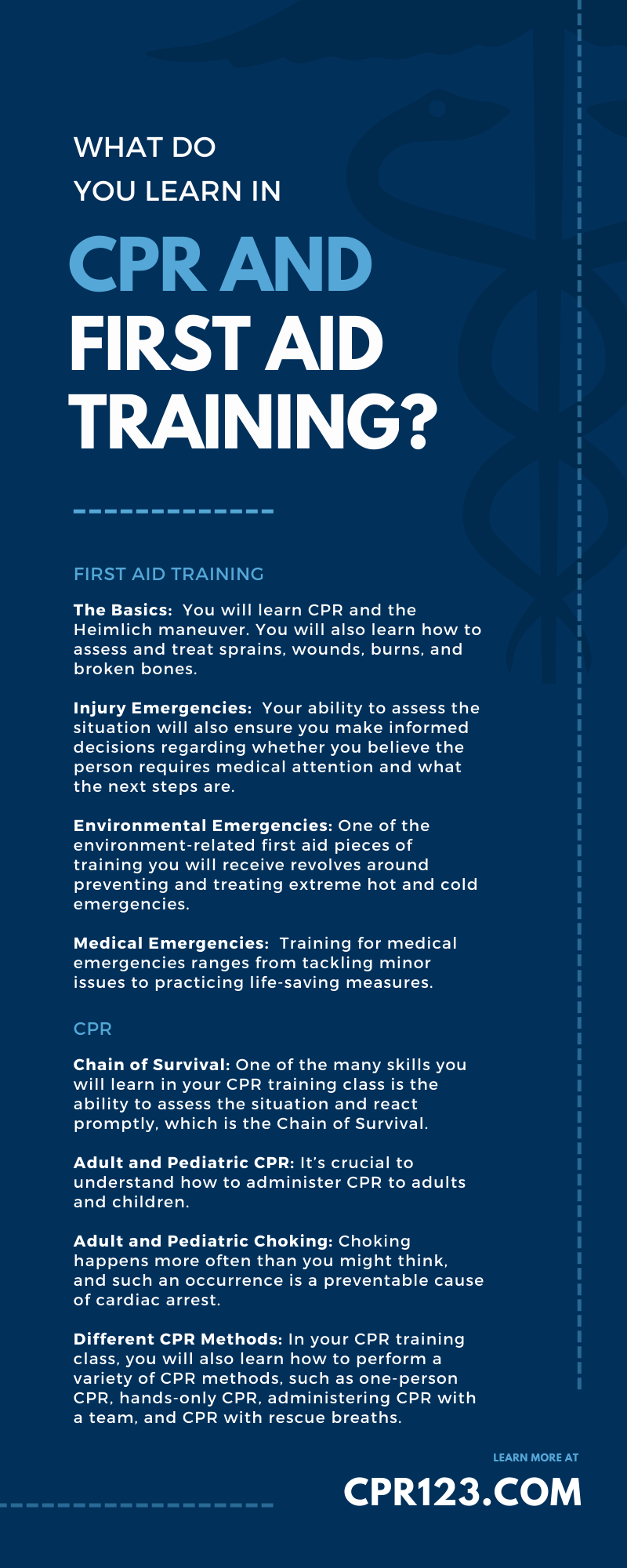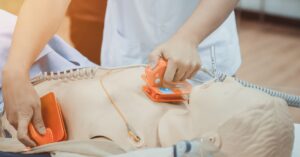Anyone could experience a sudden cardiac arrest or medical emergency at any moment in any place. In fact, most cardiac arrests occur outside of a medical setting, whether in public or at home.
You could find yourself in such an emergency that might require you to take action. Knowing what to do in such situations is likely why you signed up for training. However, you might not know what to expect during your courses. Find out more about what you learn in CPR and first aid training.
Confidence
Many people will freeze when faced with a sudden and emergent situation, as they don’t have the internal training to know what to do. The most important thing your instructors will equip you with is the confidence to respond appropriately to an emergency. With knowledge comes great confidence and the responsibility to do your best with what you have.
First Aid Training
When you sign up to learn first aid, you might not know what to expect—this topic tends to cover a wide range of things. As such, it’s normal to wonder what you will learn in your CPR and first aid training. The purpose of your training is to equip you with the mental know-how and education that allows you to respond promptly in a variety of urgent situations. When you have this training, you have the ability to assess an emergency and immediately work to remedy it for the survival and safety of the victim.
The Basics
The first things you will learn in your first aid training are the most common or basic procedures. As such, you will learn CPR and the Heimlich maneuver. You will also learn how to assess and treat sprains, wounds, burns, and broken bones. With how much knowledge this training covers, you are likely excited to enroll and start learning to help others!
However, you want to ensure you choose the best training center that can accommodate your needs. Consider signing up for courses with CPR123. When you receive your Heartsaver certification with us, we will equip you with the most in-depth first aid CPR AED training you could need. You will walk away confident for nearly any medical emergency that might arise when you finish our courses.
Injury Emergencies
Imagine you’re on a hike, and someone near you experiences a slip that leaves them clutching their foot in pain. They could have a wound, sprain, or even a broken bone. This situation is an example of an injury emergency. You might wonder what you could possibly do to help and assist them, which is what first aid training aims to teach you.
In most cases, you might only have to elevate the foot and apply a cold compress. However, your ability to assess the situation will also ensure you make informed decisions regarding whether you believe the person requires medical attention and what the next steps are.
Environmental Emergencies
Despite the fact that many of us enjoy going out in nature to bask in the wonderful sights, this activity doesn’t come without risk. It’s no secret that humans can be quite vulnerable to the ever-changing elements and the unknowns of nature.
One of the environment-related first aid pieces of training you will receive revolves around preventing and treating extreme hot and cold emergencies. We are also subject to wild animals when we explore, which is why you will also learn how to avoid and treat stings and bites from various critters.
Medical Emergencies
Medical emergencies cover a wide range of urgent situations. Training for medical emergencies ranges from tackling minor issues to practicing life-saving measures. For example, you will learn the common causes and how to treat issues ranging from nose bleeds and bee stings to burns and blood loss. Moreover, you will learn how to treat cardiac arrest or help someone who is choking.
CPR
CPR, short for Cardiopulmonary Resuscitation, is a science-based procedure that the American Heart Association (AHA) developed for someone to administer to a victim in the event of a cardiac arrest. A cardiac arrest is an often-fatal event wherein the heart stops pumping blood unexpectedly. CPR is an incredibly important skill to know; the best part is that nearly everyone can learn it.
Chain of Survival
One of the many skills you will learn in your CPR training class is the ability to assess the situation and react promptly, which is the Chain of Survival. The Chain of Survival is a chain of events that one must implement in instant progression to diminish the chances of a cardiac arrest becoming fatal. Anyone with CPR training can incite the Chain of Survival, whether a paramedic or bystander.
Adult and Pediatric CPR
Many people don’t realize that cardiac arrests can occur to anyone at any age. It’s crucial to understand how to administer CPR to adults and children. You wouldn’t administer the chest compressions on a baby that you would on an adult. However, if you want to learn how to practice this measure for both adult and pediatric victims, you must ensure the class you sign up for offers that training.
Adult and Pediatric Choking
Choking happens more often than you might think, and such an occurrence is a preventable cause of cardiac arrest. The reason choking can incite a cardiac arrest is due to the obstruction causing blockage of the airway. As such, the victim won’t be able to receive enough oxygen to their body. You can benefit from learning how to provide adult and pediatric choking relief.
Different CPR Methods
When you imagine someone administering CPR, you are likely to imagine mouth-to-mouth resuscitation, but there are more methods than that. In your CPR training class, you will also learn how to perform a variety of CPR methods, such as one-person CPR, hands-only CPR, administering CPR with a team, and CPR with rescue breaths.
Taking a CPR and first aid training course empowers you to make a difference in an emergency. While covering serious topics, these classes can be fun to attend and help you overcome fears of being unable to assist those in need.








